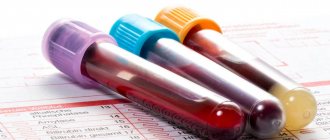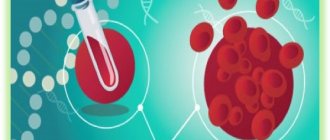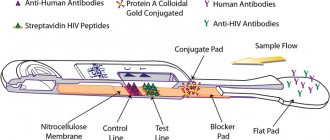What is an allergy test?
- Urgent call to a doctor at home
An allergy test is a common laboratory test that can be used to identify the source of the disease - the allergen, or determine a person’s predisposition to allergies. For this purpose, a specific immunoglobulin test is performed. This analysis can accurately identify allergens that cause an enhanced immune response in the body. To carry it out, blood is taken, which is then mixed with various allergens from contact (household chemicals, detergents), inhalation (pollen, wool, house dust, food for aquarium fish, fungal spores, etc.) and food groups.
Check your symptoms with signs of allergies
Allergic reactions are very diverse. However, there are a number of Allergy Blood Tests symptoms that are most common:
- nasal congestion;
- allergic rhinitis - the nose runs for no reason;
- attacks of obsessive dry cough;
- endless sneezing;
- red eyes that are itchy and watery;
- diarrhea;
- nausea, sometimes even vomiting;
- itching of the skin, which is accompanied by the appearance of spots, flaky areas or rashes, and sometimes swelling.
The most severe stage of allergy is anaphylactic shock. In this case, the body's immune response to the allergen is so strong that it threatens life. If you notice swelling in the face, lips, tongue, neck, as well as difficulty breathing, dizziness, weakness, then call an ambulance immediately.
What is specific immunoglobulin
Specific immunoglobulin, or IgE, is an antibody involved in the development of allergies. They are present in human tissues that come into contact with the external environment - skin, tonsils, adenoids, respiratory tract, gastrointestinal tract. Present in the bloodstream in small quantities. When IgE molecules combine with antigens, an immediate hypersensitivity reaction develops. An analysis for immunoglobulins allows you to determine their quantitative content in the blood and, based on the data obtained, draw a conclusion about your predisposition to allergies.
Allergen panel
Food allergen panel
Nowadays, it is best to donate blood for allergens and get the most accurate and detailed result for the available allergens using the immunoblotting method. It is an accurate and fast way to obtain results using special nitrocellulose membranes on which specific types of proteins are applied in stripes. If a specific allergen is present, the strip responsible for it darkens. This method is characterized by a high degree of information content, accuracy and reliability of the data obtained. It also has no contraindications and can be used for all people.
To conduct the study, allergen panels are used - standard sets on which markers of various allergens are applied in a certain order.
Most often there are 4 main panels in use:
- Mixed panel. It includes the following allergens - dust mite I, dust mite II, pollen from birch catkins, flowering hazel and alder catkins, various herbaceous plants, rye ear and inflorescences of wormwood, plantain, wool and epithelial cells of a cat, dog, horse, fungus, chicken protein eggs, dairy products, ground and hazelnuts, carrots, wheat flour, soybeans.
- Inhalation panel. It includes the following allergens: mite I and II, pollen produced by the inflorescences of alder, birch, hazel oak, mixtures of herbaceous plants, rye, wormwood, plantain pollen, particles of epithelium and hair of cats, horses, dogs, guinea pigs, hamsters, rabbits , fungi.
- Food panel. Includes the following products: hazelnuts, almonds, peanuts and walnuts, dairy products, egg whites and yolks, casein, potatoes, celery, carrots, tomatoes, cod, crabs, oranges, apples, wheat and rye flour, sesame seeds, soybeans.
- Pediatric panel: house dust mite 1, house dust mite 2, birch pollen, mixtures of herbs, cat, dog epithelium and hair, fungus, milk, alpha-lactoalbumin, beta-lactoglobulin, casein, egg yolk and white, beef serum albumin, soybean , carrots, potatoes, wheat flour, hazelnuts, peanuts.
The obtained data are estimated in the range from 0.35 to 100 kU/l. A reading below 0.35 means that no signs of allergy have been detected. All other data, as they increase, indicate the presence of sensitivity to certain allergens in the body.
However, the numbers do not indicate the severity of the disease; only an allergist can interpret them, based on the entire range of information he has about the patient.
After testing for allergens and accurately identifying the cause of the disease, the doctor will make a diagnosis and draw up an action plan, which will include the elimination of substances that provoke an acute reaction of the body, medication and auxiliary treatment. With such an integrated, comprehensive approach, allergies can be dealt with most quickly.
Noticed a mistake? Select it and press Ctrl+Enter to let us know.
Source
Indications for blood tests for allergies
allergy tests if:
– there are clear signs of an allergic reaction that occur seasonally, after eating certain foods or contact with any substances;
– drug treatment of rhinitis, bronchitis (in the chronic stage), conjunctivitis, dermatitis did not bring results;
– the patient has a tendency to allergies due to hereditary predisposition;
– when working in hazardous industries, the patient has constant complaints of cough, rhinitis, conjunctivitis and other symptoms of an allergic reaction;
– it is necessary to determine the state of the immune reaction after the onset of an allergy.
Basic methods of testing blood for allergens
There are two most common examination methods in all medical institutions that help identify a pathological immune reaction to a particular substance that causes increased production of specific antibodies. Signs of an allergy in a person are an immune reaction that occurs upon contact with any substance that causes the release of specific type E immunoglobulins. It is they that provoke the appearance of all the symptoms of the disease. The disease can manifest itself after contact with the epidermis, mucous membranes, in the gastrointestinal tract, and so on.
Allergy testing should be done in a medical facility with qualified laboratory staff and appropriate equipment. At the Axis medical center in Zelenograd you will receive high-quality service and accurate examination results. It is with their help that there will be a substance that provokes the appearance of negative allergic reactions.
At the moment, there are two allergy tests where blood is taken for allergens:
RAST test
This method is preliminary, since it does not cover the entire list of substances and products that are allergens. It helps indicate the right direction for subsequent research. If the test reaction is positive, the patient will be prescribed other tests that accurately determine the allergen that affects health. For analysis, a small amount of venous blood is taken and evenly distributed into separate tubes. One type of allergen is added to them in the form of a solution. An increased amount of antibodies secreted by the body, the immune system, helps determine hypersensitivity. The laboratory report will indicate a positive, active reaction to this particular pathogen.
Specific immunoglobulin E test
This examination will identify all allergens that cause the disease in a particular patient. Specific substances identified during the RAST test are also added to the blood collected within a short time. Allergens have three groups:
- Inhaled allergens or inhaled pathogens. These include pollen, dust, feathers, animal hair, and so on.
- Contact, causing allergies upon direct contact. These are mainly components of cosmetics and various household and cleaning chemicals.
- Food is the most extensive area of allergology, as it has hundreds of samples, because almost any food can cause an increase in the production of antibodies.
Study design
As a rule, a blood test to identify allergens consists of three successive stages. First of all, allergy status is diagnosed. It allows you to determine whether the patient has an allergy or not. For this purpose, food, general inhalation, mold tests and an assessment of immunoglobulin E are carried out. If at the first stage at least one positive reaction is detected, then testing with mixtures of allergens is performed. These include food (poultry and meat products, fish, vegetables and cereals, nuts and fruits), as well as inhalation (animal hair and house dust, tree and cereal pollen, mold) groups of substances. If a positive result is established, you will need to take an allergy test again for specific categories.
Make sure it's really an allergy

Allergies are one of those “simple” diagnoses that you’re tempted to make yourself. But this cannot be done. For a simple reason: dozens of other diseases are similar to allergies - from acute respiratory viral infections, worms and lichen to asthma.
Therefore, if you find yourself with symptoms similar to signs of an allergic reaction, the best solution is to go to the therapist.
The doctor will listen to your complaints, conduct an examination, and ask additional questions: about your lifestyle, the products and medications you use, the household chemicals and cosmetics you use, and your pets. Perhaps the therapist will suggest another diagnosis that you have not even thought about and will ask you to take tests - for example, stool tests to rule out a parasitic infection.
Screening tests
For mixed allergies and other complex cases, a comprehensive analysis is required - a screening method using panels of food and inhalation allergens (from 50 to several hundred items). This is a fast and fairly economical technology that allows not only to compile a list of substances to which the body exhibits an increased response, but also illustrates their combined effects. In some cases, screening tests are performed with a large number of individual allergens. To save costs, a rapid screening with 12 food substances or 12 inhalant substances, or an extended level 1, 2 or 3 test can be performed.
Methods of specific allergy diagnostics
- Enzyme immunoassay for allergen determination. This study is prescribed to measure the amount of specific immunoglobulins IgE in the patient’s blood. Normally, the total immunoglobulin level is in the range of 20–120 units/ml. In the presence of allergies, this threshold is significantly increased.
- Comprehensive analysis of food allergens - determination of specific IgG4 immunoglobulins, grouped into so-called allergopanels (food groups), optimally selected for cross-reactions.
- RAST test (radioallergosorbent). This test is used to determine the concentration of immunoglobulins IgE and IgG in the blood. With its help, an allergy is detected, but the degree of sensitivity to the foreign protein that causes it is not determined.
- Immunofluorescence analysis for allergens is currently considered the “gold standard” in the diagnosis of allergic pathologies. Using the ImmunoCap method, which is a true quantitative test, the concentration of IgE in the blood serum is assessed and the functional state of the body is determined. When conducting the study, individual allergens (about 280 pieces), panels of food and inhalation allergens, panels for determining allergens of animals, dust mites, grasses, fungi, etc. are used.
- The MAST test allows you to identify changes in the functional activity of phagocytes when they interact with specific agents.
- Immunoblot is a highly specific and highly sensitive reference technique that confirms the diagnosis in case of a positive or indeterminate ELISA result.
- Immunochromatographic analysis is a test for allergens that involves the use of special rapid tests. This method is used when studying serum, plasma or whole blood.
How to prepare to donate blood
A blood test for allergens is performed during the period of remission on an empty stomach. This is required to ensure that the IgE level is as close to normal as possible. The patient is advised, if possible, to stop taking any medications, including antihistamines. However, such a restriction is introduced only at the request of a doctor. It is not advisable to take allergy tests in acute health conditions (fever, viral infections, gastrointestinal diseases in the acute stage, etc.). Immediately 3-5 days before the test, all highly allergenic foods should be excluded from the diet. Avoid contact with animals whenever possible. You should refrain from smoking 2 hours before the test.
Indications for laboratory testing
- Atopic dermatitis, eczema, neurodermatitis and other pathological conditions accompanied by significant damage to the skin.
- Increased skin sensitivity, which can cause false-positive or false-negative results.
- Discomfort during skin tests.
- Severe dermographism (skin reaction to mechanical irritation).
- The need for constant use of antiallergic drugs that reduce sensitivity to allergens during skin tests.
- Infancy.
- A history of anaphylaxis or the likelihood of its development.
The ABC-MEDICINE clinic in Moscow, which provides a wide range of outpatient services, has implemented an integrated approach to the problem of diagnosis and treatment of allergy pathologies. With us you can take a blood test for allergens, the price of which depends on the diagnostic method, and also, if necessary, undergo a full course of treatment developed in accordance with international standards for the treatment of histamine-dependent allergic diseases.











